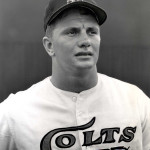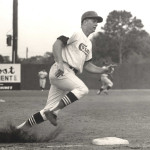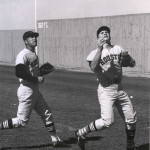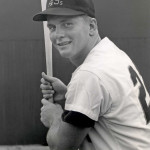The “Old-School” Baseball philosophy into which I was officially indoctrinated in the Fall of 1962 was primarily one of Action, and pre-oriented to the acclamation of Physical prowess, with little or no accommodation for the “independent – thinker” who might, if left to the initiative of his imagination, reconstruct a new paradigm that would confuse and contaminate the current and traditional standard of Baseball excellence. I fit in perfectly since I was not really much a student of the game as I was and wanted to be a phenomenal exhibit to the physical grandeur of all the glory that Baseball could be at that time.
Function was secondary to Form, for without the true understanding of what it took to be a “Big-League” player, I was more concerned about what I could do to look like a “Big-Leaguer.” I wanted to look like Mickey Mantle; run like Mickey Mantle; have the power of Mickey Mantle. I basically accomplished those “superficial” goals with arduous and meticulous devotion, but at the cost of neglecting the more substantive aspects for which the game of baseball possibly could have had a more enduring effect.

Physically I could do more, and did more, than anyone with whom I was put in competition. I was 6 feet 2 inches tall, and weighed 210 lbs of “rock-solid-muscle”with a 19 and 1/2 inch neck. When everyone else would jog their laps around the field, I would sprint, wearing leg weights around my ankles and harnessed around my chest and back.  Any spare time, while not on the practice field, I’d be doing strength-building exercises with pulleys and “machinery” other than “weights” (my dad didn’t believe in “weights”- it could make me muscle-bound).
Any spare time, while not on the practice field, I’d be doing strength-building exercises with pulleys and “machinery” other than “weights” (my dad didn’t believe in “weights”- it could make me muscle-bound).
Most “baseball” people couldn’t help but be impressed with the things I would do, on and off the field. On the field, at times I would demonstrate prodigious power batting. On defense, I could run and play Center-field as good as or better than “Mickey Mantle.” I did and wanted to do things that I never saw players do before. I “backed-up” everyone. If any ball got passed a charging left-fielder, I was always there to prevent the runner from advancing. When I was playing left-field I had occasions to tag runners out at third–base.
After a third out, I would sprint to the dugout in an attempt to beat the third or first baseman. When I got a walk, I sprinted to first base. I was actually “Charlie-Hustle” before Pete Rose was. Off the field I consumed vast amounts of food that I felt I needed to sustain my physical prowess as well as continue the “myths” that were surrounding legendary feats of incomparability. I was photographed once holding 5 bats in one hand, and 5 sandwiches in the other. And legend had it that I was banned from the “all-you-can-eat” Miners’ Shack in the Superstition Mountains of Apache Junction, Arizona.
My “thinking” prowess, although ensconced in the higher levels of “superficiality” would have been all that the “old-school” mentality would want to highlight and develop for the future. So it was no doubt with great disappointment that after experiencing the greatest moment in my baseball career (and arguably in Baseball history), at the age of 18 I was soon to become just another footnote to the remarkable saga of Sports figures who have experienced both the glory and gloom of athletic competition.
But, as a tribute to what is called the “human spirit,” the phoenix can rise from the ashes and attain an even higher glimpse a noble achievement. As Shakespeare’s Hamlet deliberated the moment, he pronounced, “There is nothing Good, or Bad, but thinking makes it so!”
My exposure to the “Thinking Man’s Game” began even while I was still enamored with the seemingly simplistic batting perspective of, “see ball, attack ball, hit ball,” and rely solely on my quick reflexes and strength and speed to overcome the pitched ball. I soon found out that, on the professional level, the speed of the “fast-ball” and the curve of the “Curve-ball” and the other subtle varieties of pitches were not the same as I was used to in the “small-pond.” Although I always showed enormous “potential” as a hitter, I was inconsistent (to say the least).
So, when I took the occasional opportunity to conscientiously observe players like Rusty Staub, Joe Morgan, JIm Wynn, and others, players who were less concerned about merely “looking the part” but rather “being and doing the Part,” I discerned that there was a higher and more discriminating pattern of thinking that preceded their intentions at the “plate.” They possessed a more sincere and genuine “IDEA” about what was transpiring before them. Perhaps I too would have acquired such a “mental-approach,” but that really never started to be realized until my playing days were over. “If I knew then, what I know now…”
Part 2 will focus on the evolution of patterns of thought that revolutionized my approach to more competently understanding the Game of Baseball. “THE TIME FOR THINKERS HAS COME!”